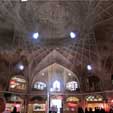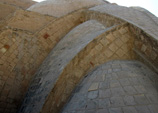Masons at Work
Stefania Petralla
Politecnico di Bari

Stefania Petralla
Politecnico di Bari
Arches and Ribbed Vaults of the Iranian Tradition
Spanning with ribbed vaults is largely diffused in several countries. In Iran ribbed vaults represent one of the most prominent elements of local architecture, with peculiar constructive techniques, never developed abroad.
The maturation of this technique is connected with the materials used, which consist primarily in bricks and suffers the shortage of timber. This peculiar condition encouraged arches construction improvement that, from the 10th up to the 18th, reached new heights of achievement. Using patterns of intersecting bricks arches so made it possible to create elaborated ribbed vaulting, both structural and decorative. The aim is to analyze spaces with this coverings, showing the ability of brick workers who, starting from a structural problem, declined in several ways its formal potentialities making a weakness be a masterpiece.
Thus up to that method, recently studied by Tehrani ("Diversi Tipi di forme e relativi stampi per le coperture tradizionali a volta in Iran", Bollettino Ingegneri, 2009, Firenze) but still poorly documented, called kār-bandi, defined as "a composition of diagonal arches that intersect when spanning in different directions, in which case the points of intersection are used to form a vault" (Dictionary of Terms used in Traditional Persian Architecture (Persian), Fallahfar S., 1999), that preserves a local Iranian declination for a typical Islamic topic.
The maturation of this technique is connected with the materials used, which consist primarily in bricks and suffers the shortage of timber. This peculiar condition encouraged arches construction improvement that, from the 10th up to the 18th, reached new heights of achievement. Using patterns of intersecting bricks arches so made it possible to create elaborated ribbed vaulting, both structural and decorative. The aim is to analyze spaces with this coverings, showing the ability of brick workers who, starting from a structural problem, declined in several ways its formal potentialities making a weakness be a masterpiece.
Thus up to that method, recently studied by Tehrani ("Diversi Tipi di forme e relativi stampi per le coperture tradizionali a volta in Iran", Bollettino Ingegneri, 2009, Firenze) but still poorly documented, called kār-bandi, defined as "a composition of diagonal arches that intersect when spanning in different directions, in which case the points of intersection are used to form a vault" (Dictionary of Terms used in Traditional Persian Architecture (Persian), Fallahfar S., 1999), that preserves a local Iranian declination for a typical Islamic topic.


